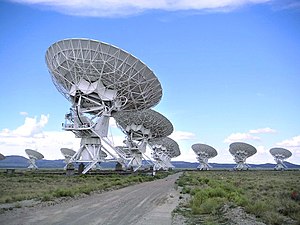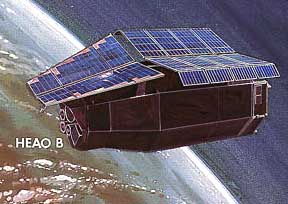From Wikipedia, the free encyclopedia
A telescope is an instrument that aids in the observation of remote objects by collectingelectromagnetic radiation (such as visible light). The first known practical telescopes were invented in the Netherlands at the beginning of the 17th century, using glass lenses. They found use in terrestrial applications and astronomy.
Within a few decades, the reflecting telescope was invented, which used mirrors. In the 20th century many new types of telescopes were invented, including radio telescopes in the 1930s and infrared telescopes in the 1960s. The word telescope now refers to a wide range of instruments detecting different regions of the electromagnetic spectrum, and in some cases other types of detectors.
The word "telescope" (from the Greek τῆλε, tele "far" and σκοπεῖν, skopein "to look or see"; τηλεσκόπος, teleskopos "far-seeing") was coined in 1611 by the Greek mathematician Giovanni Demisiani for one of Galileo Galilei's instruments presented at a banquet at the Accademia dei Lincei.[1][2][3] In the Starry Messenger Galileo had used the term "perspicillum".
Contents[hide] |
[edit]History
Main article: History of the telescope
The earliest recorded working telescopes were the refracting telescopes that appeared in theNetherlands in 1608. Their development is credited to three individuals: Hans Lippershey andZacharias Janssen, who were spectacle makers in Middelburg, and Jacob Metius ofAlkmaar.[4] Galileo heard about the Dutch telescope in June 1609, built his own within a month,[5] and greatly improved upon the design in the following year.
The idea that the objective, or light-gathering element, could be a mirror instead of a lens was being investigated soon after the invention of the refracting telescope.[6] The potential advantages of using parabolic mirrors—reduction of spherical aberration and no chromatic aberration—led to many proposed designs and several attempts to build reflecting telescopes.[7] In 1668, Isaac Newton built the first practical reflecting telescope, of a design which now bears his name, the Newtonian reflector.
The invention of the achromatic lens in 1733 partially corrected color aberrations present in the simple lens and enabled the construction of shorter, more functional refracting telescopes. Reflecting telescopes, though not limited by the color problems seen in refractors, were hampered by the use of fast tarnishing speculum metal mirrors employed during the 18th and early 19th century—a problem alleviated by the introduction of silver coated glass mirrors in 1857,[8] and aluminized mirrors in 1932.[9] The maximum physical size limit for refracting telescopes is about 1 meter (40 inches), dictating that the vast majority of large optical researching telescopes built since the turn of the 20th century have been reflectors. The largest reflecting telescopes currently have objectives larger than 10 m (33 feet).
The 20th century also saw the development of telescopes that worked in a wide range of wavelengths from radio to gamma-rays. The first purpose built radio telescope went into operation in 1937. Since then, a tremendous variety of complex astronomical instruments have been developed.
[edit]Types of telescopes
| This section needs additional citations for verification. (July 2008) |
The name "telescope" covers a wide range of instruments. Most detect electromagnetic radiation, but there are major differences in how astronomers must go about collecting light (electromagnetic radiation) in different frequency bands.
Telescopes may be classified by the wavelengths of light they detect:
- X-ray telescopes, using shorter wavelengths than ultraviolet light
- Ultraviolet telescopes, using shorter wavelengths than visible light
- Optical telescopes, using visible light
- Infrared telescopes, using longer wavelengths than visible light
- Submillimetre telescopes, using longer wavelengths than infrared light
| Light Comparison | |||||||
| Name | Wavelength | Frequency (Hz) | Photon Energy (eV) | ||||
|---|---|---|---|---|---|---|---|
| Gamma ray | less than 0.01 nm | more than 10 EHZ | 100 keV - 300+ GeV | X | |||
| X-Ray | 0.01 to 10 nm | 30 PHz - 30 EHZ | 120 eV to 120 keV | X | |||
| Ultraviolet | 10 nm - 400 nm | 30 EHZ - 790 THz | 3 eV to 124 eV | ||||
| Visible | 390 nm - 750 nm | 790 THz - 405 THz | 1.7 eV - 3.3 eV | X | |||
| Infrared | 750 nm - 1 mm | 405 THz - 300 GHz | 1.24 meV - 1.7 eV | X | |||
| Microwave | 1 mm - 1 meter | 300 GHz - 300 MHz | 1.24 meV - 1.24 µeV | ||||
| Radio | 1 mm - km | 300 GHz - 3 Hz | 1.24 meV - 12.4 feV | X | |||
As wavelengths become longer, it becomes easier to use antenna technology to interact with electromagnetic radiation (although it is possible to make very tiny antenna). The near-infrared can be handled much like visible light, however in the far-infrared and submillimetre range, telescopes can operate more like a radio telescope. For example the James Clerk Maxwell Telescope observes from wavelengths from 3 μm (0.003 mm) to 2000 μm (2 mm), but uses a parabolic aluminum antenna.[10] On the other hand, the Spitzer Space Telescope, observing from about 3 μm (0.003 mm) to 180 μm (0.18 mm) uses a mirror (reflecting optics). Also using reflecting optics, the Hubble Space Telescope with Wide Field Camera 3 can observe from about 0.2 μm (0.0002 mm) to 1.7 μm (0.0017 mm) (from ultra-violet to infrared light).[11]
- Fresnel Imager, an optical lens technology
- X-ray optics, optics for certain x-ray wavelengths
Another threshold in telescope design, as photon energy increases (shorter wavelengths and higher frequency) is the use of fully reflecting optics rather than glancing-incident optics. Telescopes such as TRACE and SOHO use special mirrors to reflect Extreme ultraviolet, producing higher resolution and brighter images then otherwise possible. A larger aperture does not just mean more light is collected, it is collected at a higher diffraction limit.
Telescopes may also be classified by location: ground telescope, space telescope, or flying telescope. They may also be classified by whether they are operated by professional astronomers or amateur astronomers. A vehicle or permanent campus containing one or more telescopes or other instruments is called an observatory.
[edit]Optical telescopes
Main article: Optical telescope
An optical telescope gathers and focuses light mainly from the visible part of the electromagnetic spectrum (although some work in the infrared and ultraviolet).[12] Optical telescopes increase the apparent angular size of distant objects as well as their apparent brightness. In order for the image to be observed, photographed, studied, and sent to a computer, telescopes work by employing one or more curved optical elements, usually made from glass lenses and/or mirrors, to gather light and other electromagnetic radiation to bring that light or radiation to a focal point. Optical telescopes are used forastronomy and in many non-astronomical instruments, including: theodolites (including transits),spotting scopes, monoculars, binoculars, camera lenses, and spyglasses. There are three main optical types:
- The refracting telescope which uses lenses to form an image.
- The reflecting telescope which uses an arrangement of mirrors to form an image.
- The catadioptric telescope which uses mirrors combined with lenses to form an image.
Beyond these basic optical types there are many sub-types of varying optical design classified by the task they perform such as Astrographs, Comet seekers, Solar telescope, etc.
[edit]Radio telescopes
Main article: Radio telescope
Radio telescopes are directional radio antennas used for radio astronomy. The dishes are sometimes constructed of a conductive wire mesh whose openings are smaller than thewavelength being observed. Multi-element Radio telescopes are constructed from pairs or larger groups of these dishes to synthesize large 'virtual' apertures that are similar in size to the separation between the telescopes; this process is known as aperture synthesis. As of 2005, the current record array size is many times the width of the Earth—utilizing space-based Very Long Baseline Interferometry (VLBI) telescopes such as the Japanese HALCA (Highly Advanced Laboratory for Communications and Astronomy) VSOP (VLBI Space Observatory Program) satellite. Aperture synthesis is now also being applied to optical telescopes using optical interferometers (arrays of optical telescopes) and aperture masking interferometry at single reflecting telescopes. Radio telescopes are also used to collect microwave radiation, which is used to collect radiation when any visible light is obstructed or faint, such as from quasars. Some radio telescopes are used by programs such as SETI and the Arecibo Observatory to search for extraterrestrial life.
[edit]X-ray telescopes
Main article: X-ray telescope
X-ray telescopes can use X-ray optics, such as a Wolter telescopes composed of ring-shaped 'glancing' mirrors made of heavy metals that are able to reflect the rays just a few degrees. The mirrors are usually a section of a rotated parabola and a hyperbola, or ellipse. In 1952, Hans Wolter outlined 3 ways a telescope could be built using only this kind of mirror.[14][15] Examples of an observatory using this type of telescope are the Einstein Observatory, ROSAT, and theChandra X-Ray Observatory. By 2010, Wolter focusing X-ray telescopes are possible up to 79 keV.[13]
[edit]Gamma-ray telescopes
Higher energy X-ray and Gamma-ray telescopes refrain from focusing completely and use coded aperture masks: the patterns of the shadow the mask creates can be reconstructed to form an image.
X-ray and Gamma-ray telescopes are usually on Earth-orbiting satellites or high-flying balloons since the Earth's atmosphere is opaque to this part of the electromagnetic spectrum. However, high energy x-rays and gamma-rays do not form an image in the same way as telescopes at visible wavelengths. An example of this type of telescope is the Fermi Gamma-ray Space Telescope.
The detection of very high energy gamma rays, with shorter wavelength and higher frequency than regular gamma rays, requires further specialization. An example of this type of observatory is VERITAS. Very high energy gamma-rays are still photons, like visible light, whereas cosmic-rays includes particles like electrons, protons, and heavier nuclei.
A discovery in 2012 may allow focusing gamma-ray telescopes.[16] At photon energizes greater than 700 keV, the index of refraction starts to increase again.[16]
[edit]High-energy particle telescopes
High-energy astronomy requires specialized telescopes to make observations since most of these particles go through most metals and glasses.
In other types of high energy particle telescopes there is no image-forming optical system. Cosmic-ray telescopes usually consist of an array of different detector types spread out over a large area. A Neutrino telescope consists of a large mass of water or ice, surrounded by an array of sensitive light detectors known as photomultiplier tubes. Energetic neutral atom observatories like Interstellar Boundary Explorer detect particles traveling at certain energies.
[edit]Other types of telescopes
- Gravitational wave detector, aka gravitational wave telescope
- Neutrino detector, aka neutrino telescope
[edit]Types of telescope mount
Main article: Telescope mount
A telescope mount is a mechanical structure which supports a telescope. Telescope mounts are designed to support the mass of the telescope and allow for accurate pointing of the instrument. Many sorts of mounts have been developed over the years, with the majority of effort being put into systems that can track the motion of the stars as the Earth rotates. The two main types of tracking mount are:
[edit]Atmospheric electromagnetic opacity
See also: Airmass
Since the atmosphere is opaque for most of the electromagnetic spectrum, only a few bands can be observed from the Earth's surface. These bands are visible – near-infrared and a portion of the radio-wave part of the spectrum. For this reason there are no X-ray or far-infrared ground-based telescopes as these have to be flown in space to observe. Even if a wavelength is observable from the ground, it might still be advantageous to fly it on a satellite due to astronomical seeing.
[edit]Telescopic image from different telescope types
Different types of telescope, operating in different wavelength bands, provide different information about the same object. Together they provide a more comprehensive understanding.







No comments:
Post a Comment